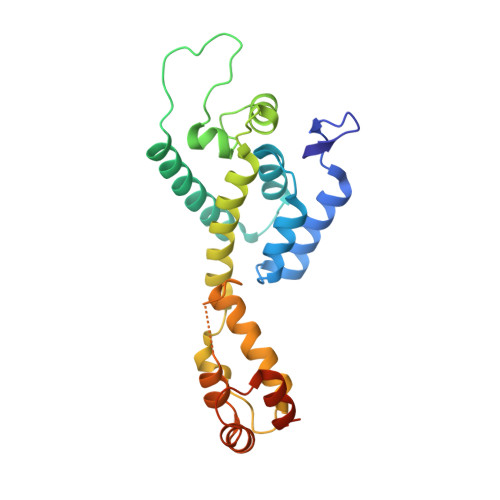Structural basis of HIV-1 capsid recognition by PF74 and CPSF6.
Bhattacharya, A., Alam, S.L., Fricke, T., Zadrozny, K., Sedzicki, J., Taylor, A.B., Demeler, B., Pornillos, O., Ganser-Pornillos, B.K., Diaz-Griffero, F., Ivanov, D.N., Yeager, M.(2014) Proc Natl Acad Sci U S A 111: 18625-18630
- PubMed: 25518861
- DOI: https://doi.org/10.1073/pnas.1419945112
- Primary Citation of Related Structures:
4QNB, 4WYM - PubMed Abstract:
Upon infection of susceptible cells by HIV-1, the conical capsid formed by ¡«250 hexamers and 12 pentamers of the CA protein is delivered to the cytoplasm. The capsid shields the RNA genome and proteins required for reverse transcription. In addition, the surface of the capsid mediates numerous host-virus interactions, which either promote infection or enable viral restriction by innate immune responses. In the intact capsid, there is an intermolecular interface between the N-terminal domain (NTD) of one subunit and the C-terminal domain (CTD) of the adjacent subunit within the same hexameric ring. The NTD-CTD interface is critical for capsid assembly, both as an architectural element of the CA hexamer and pentamer and as a mechanistic element for generating lattice curvature. Here we report biochemical experiments showing that PF-3450074 (PF74), a drug that inhibits HIV-1 infection, as well as host proteins cleavage and polyadenylation specific factor 6 (CPSF6) and nucleoporin 153 kDa (NUP153), bind to the CA hexamer with at least 10-fold higher affinities compared with nonassembled CA or isolated CA domains. The crystal structure of PF74 in complex with the CA hexamer reveals that PF74 binds in a preformed pocket encompassing the NTD-CTD interface, suggesting that the principal inhibitory target of PF74 is the assembled capsid. Likewise, CPSF6 binds in the same pocket. Given that the NTD-CTD interface is a specific molecular signature of assembled hexamers in the capsid, binding of NUP153 at this site suggests that key features of capsid architecture remain intact upon delivery of the preintegration complex to the nucleus.
Organizational Affiliation:
Department of Biochemistry and Cancer Therapy and Research Center, University of Texas Health Science Center at San Antonio, San Antonio, TX 78229;















